Włodawa
Borough of Włodawa , Włodawski District, Lubelskie VoivodshipType of place
The new Jewish cemetery in Włodawa at Mielczarskiego streetInformation about the crime
The Register of Killing Sites and Crimes for the former chełmskie province has recorded a following events in Włodawa:
- At the turn of 1939 and 1940, at the “Bug” railway station, 7 km from the city, SS and Sonderdienst officers shot 110 out of 1,100 Polish POWs of Jewish descent. The bodies were buried near the station.
- In 1942, the Germans shot 160 Jews at the railway station.
- In 1942 the Germans carried out mass executions of Poles and Jews at the local Jewish cemetery. The exact number of victims remains unknown.
- On July 2, 1943, the military policemen shot a Jew they encountered.
- July 3, 1943 the military policemen shot three Jewish women they encountered.
- In 1943, the Germans shot 110 Jews at the railway station.
We learn more about the murdered Polish soldiers of Jewish descent from eyewitness’s accounts (OKL/Ds.366/67):
“Mieczysław J. was in Chełm and was going to Włodawa by train and saw a Polish soldier crawling on his knees by the track, waving his arms and calling for help. Shots were fired from the carriage in which the gendarmerie was travelling and the train passed. He came to Włodawa, received an order from the mayor Grzegorz C. to harness the horses and go there to bring the bodies. A few Jews sent by the Judenrat went with him to load the dead victims onto a cart. According to his account, the arrangement of the bodies indicated that the victims had been finished off. They were men dressed in Polish military and civilian uniforms. While the victims were being put on the cart, a train arrived, from which shots were fired at those who were collecting the corpses, and Mieczysław J. had to flee with the cart. One victim of this murder survived and was treated in Włodawa by a Jewish family. Mieczysław J. talked to this person, which means that these people were brought towards the Bug River under the pretext of handing them over to the USSR”.
Bogdan Nowosad also mentions this event in his account filed in Jewish Historical Institute under reference number 301/7027: “In the winter of 1940, for several days, I saw the bodies of people dressed in Polish uniforms being transported to the local cemetery on sleighs. As far as I remember, they brought 360 bodies. In the evening my Jewish friends came to my parents (I remember one of them, his name was Szczuryk) with a request to resell a white canvas, about 60 cm wide, which they needed to bury the bodies”.
Witnesses who testified before the District Commission for the Investigation of Nazi Crimes in Lublin in the late 1960s mentioned mass burials at the Jewish cemetery at the peak of the Holocaust, starting in 1942:
Jan P. “Around 1942 or 1943, I had a workshop near the Jewish cemetery. Therefore, I saw executions of the Jewish population there. In 1942, in the evening, after sunset, the SD functionaries brought one or two individuals of Jewish nationality to the cemetery and shot them right outside the cemetery gate. […] In 1943, I saw the German military policemen bring to the cemetery and execute about 200 people of Jewish nationality, men and women, mostly young people. They led five people out of the line, made them lie face down on the ground and shot them in the back of the head with a pistol, and the others began to cry and scream. The military policemen ordered everyone to lie down in two lines. They walked around with pistols and shot people lying face down in the back of the head. The victims came from Włodawa and its vicinity. I watched this execution from the attic of my house, through a hole in the shingles […]”. Czyż, who lived in my apartment after I left, told me that the Germans fenced the cemetery from the side of the road with mats, many cars came and they transported the bodies, probably to Sobibór. Czyż saw all this from the attic of my house through a crack in the roof”.
Feliks F. “As far as I remember, in the summer of 1943 I saw the execution of Jewish men in the Jewish cemetery from a distance of 300 meters. The Jews lined up above the previously dug pits, and four Vlasovites from Sobibór shot at them with a machine gun. About 50 people died then. […] On the third day I brought lime to the cemetery and I saw this mass grave. It was barely covered with earth, and other people covered it with the slaked lime. In the summer of 1942, I saw an SS man shoot a Jew from Włodawa named Auter, aged about 50, and his wife, whose name I do not know. From a distance of about 200 m, I saw two SS men shoot them in the back of the head with a pistol. They were buried in the Jewish cemetery in Włodawa.” (OKL/Ds.366/67)
7)
IDENTIFICATION OF THE GRAVE BASED ON NON INVASIVE RESEARCH
As a result of the aerial photography query, two photographs with the following signatures were obtained: TUGX 931 SK frame 29 (June 21, 1940?), GX8102 SK frame 183 (May 28, 1944). The photographs show the area of the Jewish cemetery at Mielczarskiego and Jana Pawła II streets. In the photo no. TUGX 931 SK frame 29, taken probably in 1940, shows the boundaries of the Jewish cemetery and the pre-burial house located in the south-eastern corner. The photo also shows soil disturbances in the form of narrow paths, as well as clear violations at the eastern border of the plot. Disturbances or brightening may be caused by the reflection of sunlight from tombstones and potential excavations.
Further violations of the surface of the Jewish cemetery are visible in the photograph no. GX8102 SK frame 183 taken in 1944. Very clear soil disturbances are visible at the eastern border. In the south-east corner, right next to the pre-burial house, there is an extensive disturbance. Further very clear excavations can be seen towards the north. Smaller disturbances occur along the western and northern borders of the plot.
In the aerial photographs, larger soil disturbances are marked with red arrows.
GPS: 51°32’58.1″N 023°33’03.2″E
In the satellite image, the approximate locations of large soil disturbances are marked in orange.
Sources
Transkrypcje
Contact and cooperation
We are still looking for information on the identity of the victims and the location of Jewish graves in Włodawa. If you know something more, write to us at the following address: fundacjazapomniane@gmail.com.
Bibliography
The Register of Killing Sites and Crimes committed by the Germans in Poland between 1939 and 1945, chełmskie voivodeship, Warsaw, 1986
301/7027 AŻIH
OKL/Ds.366/67
Recording of the Zapomniane Foundation (audio file), name: Antoni D., resident of Adampol, key words: Jewish graves in Włodawa, Jewish cemetery in Włodawa, interviewed by Filip Szczepański, Adampol, May 25, 2019
We have collected the materials about this village thanks to the funding provided by the International Holocaust Remembrance Alliance as part of the project “The rural Holocaust. Collecting and safeguarding the never recorded testimonies 100 forgotten Jewish graves 2021-2022”. The materials for this website were developed, digitized and made available as part of the project “Development of a digital archive of Jewish war graves outside the extermination camps and educational use of archive resources” thanks to funding from the Minister of Culture and National Heritage from the Cultural Promotion Fund.
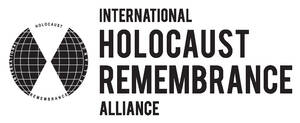
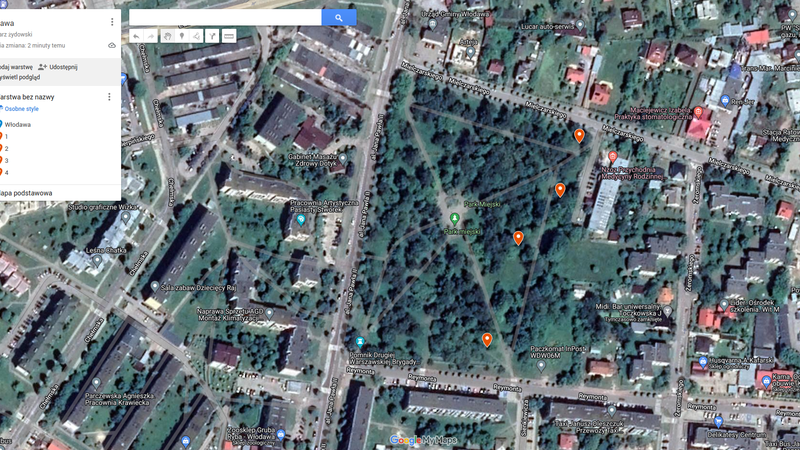 Włodawa fotografia satelitarna lokalizacji
Włodawa fotografia satelitarna lokalizacji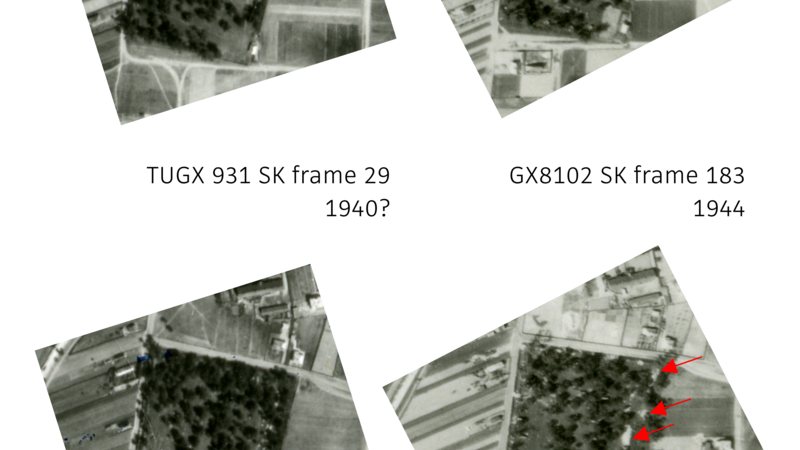 Włodawa fotografie lotnicze
Włodawa fotografie lotnicze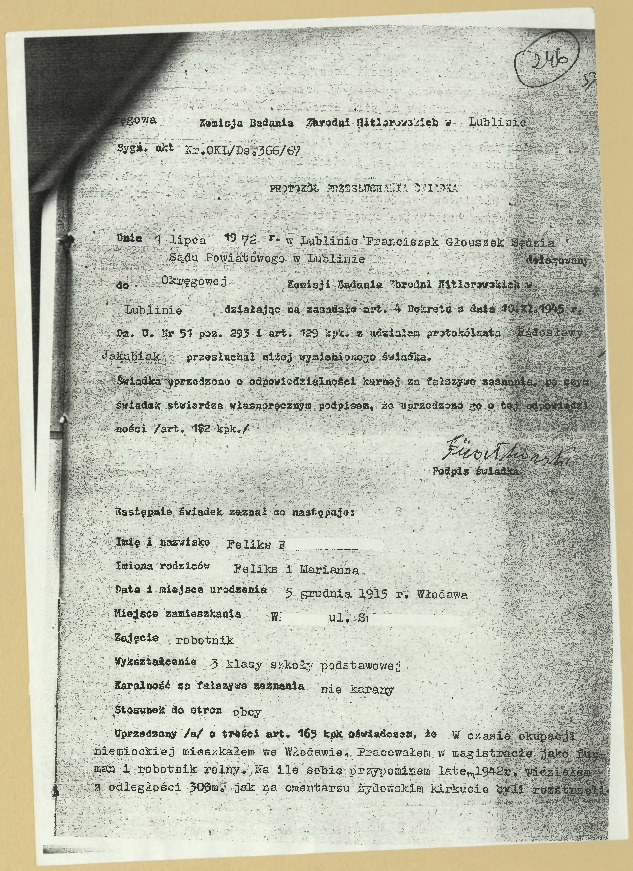 OKL Ds.366-67 - Protokół przesłuchania świadka - Feliks F. - Włodawa
OKL Ds.366-67 - Protokół przesłuchania świadka - Feliks F. - Włodawa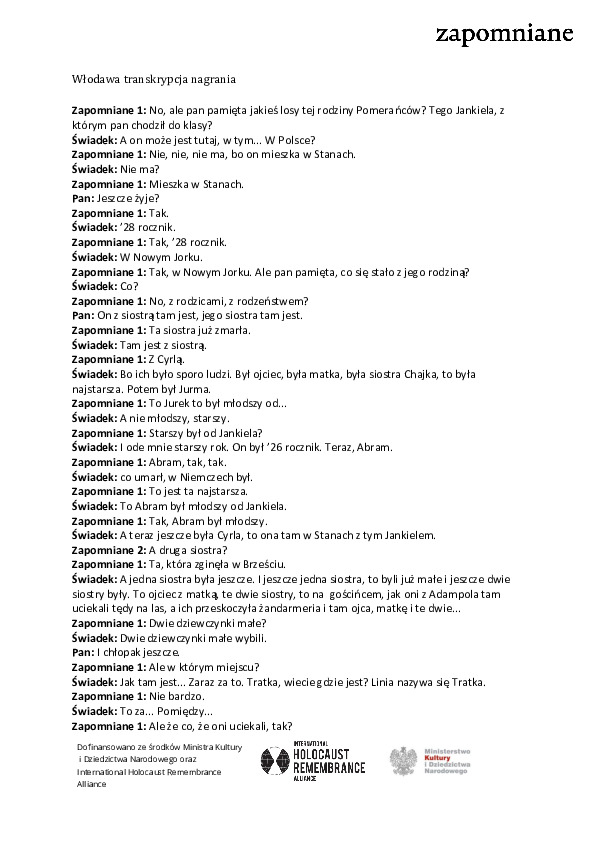 Włodawa - transkrypcja
Włodawa - transkrypcja